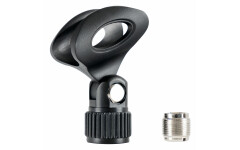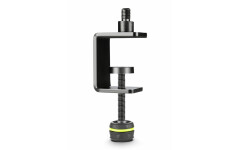Mikrofon-Windschutz aus schwarzem Schaumstoff!
Der Monacor WS-40 Windschutz sorgt bei Mikrofonen für eine zuverlässige Minimierung von Körperschallgeräuschen, wie sie etwa von starkem Wind bei Außenaufnahmen oder durch heftiges Atmen verursacht werden. Auch Popp-Laute werden wirksamer gedämpft als bei herkömmlichen Mikrofonkörben.
Ein kleines Helferlein im harten Bühnenalltag!
Specification
- Product number 00002309
- Colour Black
Person responsible for the EU
MONACOR INTERNATIONAL GmbH
Zum Falsch 36
DE-28307 Bremen
info@monacor.de
Reviews
| 5 Stars |
|
2 |
| 4 Stars |
|
0 |
| 3 Stars |
|
0 |
| 2 Stars |
|
0 |
| 1 Star |
|
0 |
A verification of the ratings has taken place as follows: Only customers who are registered in our online store and have actually purchased the product from us can submit a rating for the item in the customer account.
This rating has been translated automatically. Original language
AKG P 170
Audix ADX 51
Audio-Technica AT 2031, 4021, 4022, 4041, 4049, 4051, 4053
Audio-Technica ATM 450
Audio-Technica PRO 24
Beyerdynamic MCE 530, TG I 53, Opus 53
Beyerdynamic MC 910, 930, 950
Neumann KM 183, 184, 185
Neumann KM A/D + capsules KK xxx
Sennheiser E 914
Sennheiser K6 + capsule ME 64
Shure SM 81, SM 137 LC, KSM 137 SL, KSM 141 SL
Not suitable for candidates that are too narrow (diameter less than 21 mm, slips off!), e.g.:
AKG C 391 (SE 300 + capsules CK 9x)
AKG C 430
AKG C 451 EB (and predecessor with capsule CK1)
Audix f9
Rode M 5, NT 5
Sennheiser E 614
Sennheiser MKH xxxx
Schoeps CMC 5/6 + capsules
Be careful with the special case Beyerdynamic M 201:
Its diameter is 24 mm, but the sound inlet slots extend slightly lower down the shaft.
Therefore, the Beyerdynamic M 201 needs the windscreen, which is one cm longer.
Monacor WS-50, NOT the WS-40!
Of course, this windscreen is insufficient for shotgun microphones.
Do not expect miracles from all foam parts! They are small, useful helpers, which you can always comfortably have with you, which "sacrifice" themselves in case of moisture and dirt on the microphone, but wear out relatively soon. They can only dampen light wind / a "light breeze" sufficiently. With more wind they fail.
If you need to isolate wind noise perfectly, you can't get around a suitable fur windscreen ("Dead Cat") - from 40 € upwards, usually over 70 €.
If you only want to keep pop sounds away from the mic and record undiminished highs (in the studio), it's best to use a double-layered (fabric) pop killer - from 20 € upwards. Before choosing a popkiller, you should also consider the mounting on the tripod, the mounting of the microphone, its decoupling and the damping against footstep noise, structure-borne noise and cable resonances. With an integrated shock-mount and integrated microphone clamp in good quality, we quickly exceed 80 €. Don't forget the resulting total weight including the cable run, which has to hold or balance the extended tripod!
RAT: Don't save money at the wrong place!
Don't buy no-name-cheap junk from bad sources, which stinks, tears when you wind it up, spoils the sound or soon crumbles and thus ruins your microphone.
Get a new windscreen at least once a year - and at the latest when the old one is obviously wearing out!
Foam ages, its crumbs can penetrate into the microphone, lay on the diaphragm or change the sound/resonance spaces, in the case of condenser modular systems even contaminate their contacts. Your mic would change its sound or directionality, in extreme cases there would be distortion, dropouts or complete reverberation. Repairing a high-quality mic often costs more than half the price of a new one, which is certainly a multiple of a few banal foam windscreens. Therefore, keep 2-3 pieces in stock in the closet!
This rating has been translated automatically. Original language
Very good handling. Thank you and Merry Christmas
Questions about product
No questions have yet been asked about this article.
| 3 Year warranty | |
| 30 Day Money Back | |
| Price Match Guarantee | |
| Over 2.000.000 satisfied customers |
The hotline is currently not manned. You can reach us again on Friday, 27.12.2024 at 09:30.
| Tuesday | 09:30 - 13:00 |
Different opening times |
| Wednesday | Closed |
Different opening times |
| Thursday | Closed |
Different opening times |
| Friday | 09:30 - 18:00 | |
| Saturday | 09:30 - 13:30 | |
| Monday | 09:30 - 18:00 |












